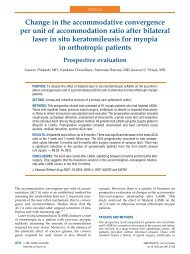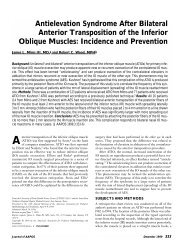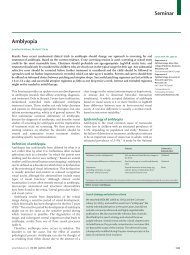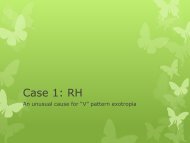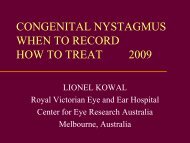What's new AAPOS 2008 - The Private Eye Clinic
What's new AAPOS 2008 - The Private Eye Clinic
What's new AAPOS 2008 - The Private Eye Clinic
Create successful ePaper yourself
Turn your PDF publications into a flip-book with our unique Google optimized e-Paper software.
and photophobia (80%). <strong>The</strong> children's greatest concerns were limitations on going to<br />
the pool (71%), playing sports (58%), and meeting friends (58%). QUICK symptom<br />
scores were correlated significantly to conjunctival hyperemia (P < .001), secretion (P =<br />
.042), chemosis (P = .012), superficial punctate keratopathy (P < .001), and TSS (P =<br />
.010).<br />
CONCLUSIONS: <strong>The</strong> QUICK questionnaire is a <strong>new</strong>, simple instrument to measure<br />
HRQoL in children with severe allergic conjunctivitis. This test is effective for the global<br />
evaluation of the impact of VKC on children's daily lives.<br />
Visual Outcome and Corneal Changes in Children with Chronic<br />
Blepharokeratoconjunctivitis<br />
Sophie M. Jones, Joel M. Weinstein, Phillippa Cumberland, N. Klein, Ken K. Nischal<br />
Ophthalmology 2007;114:2271-2280<br />
Design: Noncomparative, interventional, retrospective case series of 27 children with<br />
BKC.<br />
Methods: Presenting age, best-corrected visual acuity, refractive error, and any corneal<br />
or eyelid pathologic features were recorded. Treatment included modified lid hygiene,<br />
topical antibiotics, and steroids. Systemic therapy included oral antibiotics and (from<br />
2003 onward), flaxseed oil.<br />
Results: Mean age at presentation was 6.9 years and mean follow-up was 2.3 years.<br />
Photophobia was reported in 14 patients (52%), anterior chamber inflammation in 6<br />
(22%). Corneal involvement occurred in 44 eyes (81%), history of recurrent chalazia<br />
was seen in 18 patients (67%). Best-corrected visual acuity improved in 70% of the<br />
affected eyes and remained unchanged in 30%. Superimposed amblyopia was present<br />
and treated in 15 patients (48%). No children had significant side-effects from topical<br />
treatment.<br />
Conclusions: Visual loss may be significant in the BKC. Delayed treatment may result<br />
in decreased final BCVA. Adequate management needs both topical and systemic<br />
treatment. Flaxseed oil might be an effective anti-inflammatory alternative to long term<br />
antibiotics.<br />
Reviewer’s Comments: Close ophthalmologic surveillance is recommended for all<br />
children suspected of having blepharitis. A history of recurrent chalazia necessitates<br />
the exclusion of eyelid and corneal disease. Most children with BKC require prolonged<br />
therapy.<br />
45



